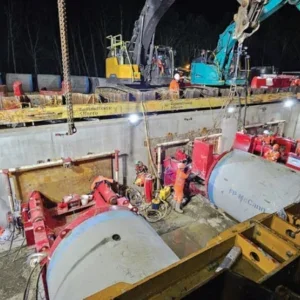This month, the Austrian Society for Geomechanics (OGG) holds its annual back-to-back events of the Austrian Tunnel Day (13th) and its Geomechanics Colloquium (71st), once again in beautiful Salzburg.
With a three-day (12-14 Oct) focus on key themes of tunnelling and geomechanics importance for clients, consultants, contractors, projects and researchers in the Alpine region, the gathering offers the hybrid opportunity of attendance to the Colloquium on site at the Congress Centre as well as online.
The Colloquium is to cover key topics of hydropower projects, grouting, mass ground movements, and artificial intelligence (AI). With such a packed programme, it is helpful that while all presentations are to be broadcast live there will be digital access to the recorded information remaining until the end of the year.
The gathering in Salzburg begins, though, with the 13th Austrian Tunnel Day (12 Oct) which in addition to looking at some major projects will also consider a number of aspects around the increasingly important subject to the industry of sustainability.
AUSTRIAN TUNNEL DAY
In a very busy schedule spread across three sessions, the Tunnel Day is to begin by hearing briefings on an overview of activities of the International Tunnelling Association (ITA), discussion by energy company Verbund on what is happening in its sector, then to have presentations on two projects – the Kostendorf-Salzburg rail line, and A26 Linzer Autobahn.
Major projects from farther afield will have a spotlight next – from Scandinavia, where presentations will briefly review works on a rail project in Gothenburg and a tunnelling challenge in Drammen, near Oslo.
Turning to sustainability as the focus for the second session, the delegates to Tunnel Day are to hear about: how blasting technology can help achieve accurate contour profiles in tunnelling; the practical experience of an innovative and emission free logistic concept for Kerenzerberg safety gallery, in Switzerland; the approaches to sustainable infrastructures development on Grand Paris Express, Line 16, especially Lot 1 where advances in practical application of low carbon concrete are being made; and, the “Mining the Future” context as part of developing the CERN-FCC Future Circular Collider project in the Alps.
Shifting from the project spotlight but keeping to sustainability focus, the last session is to discuss: spoil and waste management in the circular economy; carbon dioxide reduction in planning and implementation, including looking at materials technology; and, then round off with a panel discussion.
GEOMECHANICS COLLOQUIUM
With the noted focus on hydropower among its many areas to spotlight, the 71st Geomechanics Colloquium is to begin with that subject and considering three large current schemes in the Alps: Obervellach II hydro scheme; and, two pumped storage projects – Forbach/ Schwarzwald and Limberg III, respectively.
On Limberg III, the presentation is to look at challenges in the logistics and excavation systems to support large construction activities in a remote, high mountain region. The project is also to host a technical site visit after the Colloquium, on 15 October.
Approval to build Limberg III was obtained by Verbund in 2017 and construction began last year. The 480MW plant is to operate under a high head of 365m between two existing reservoirs, Mooserboden and Wasserfallboden. Underground works on the project involve the headraces and tailrace tunnels as well as the powerhouse caverns. Construction is getting underway about ten years after Limberg II came into operation.
On the topic of grouting, the Colloquium is to hear about: forecasting injection parameters using AI; developing dynamic grouting under laboratory and field conditions; automated execution and control of compensation grouting; experience of pre-excavation grouting (PEG) from Norway and grouting in Italy; and the drilling and grouting works on part of Semmering Base Tunnel.
The mass movement session will consider landslides. The last session will look take a focused look at AI, considering first – in a link with the last session – how data science and machine learning (ML) can help study gravitational natural hazards. Then, further presentations are to look at ML for geological modelling and rock engineering; probabilistic prediction of karst water inflow at a mine; and, hybrid ML for quality monitoring.
A LOOK AHEAD
OGG has already scheduled the 2023 events, where in Salzburg over 9-14 October the 72nd Geomechanics Colloquium will be held together with the 15th International Congress of the International Society for Rock Mechanics and Rock Mining (ISRM). The ISRM was founded in Salzburg by Leopold Müller 60 years ago. Its first international congress was held in 1966 and 2023 will be the first return to Salzburg.






